Etappe 1: Cuxhaven – Scheveningen, ca. 220 nm, ca. 38 h

Friday April 14
We start in the morning at around 10:00 in Cuxhaven with the tidal current capsizing to the west, with the aim of sailing non-stop through to Scheveningen. Initially under engine, because until early afternoon there is mostly calm. Due to the tidal current we make good progress in the first few hours and in the afternoon a northerly wind comes up near the Weser Reede, which increases towards the evening and pushes us well through the night with 4 to 5 Beaufort. With a wind angle of 120 – 180 degrees, we are able to jib out and reef the main at dusk. The speed through the water is always around 7 knots from the early evening onwards. Video:
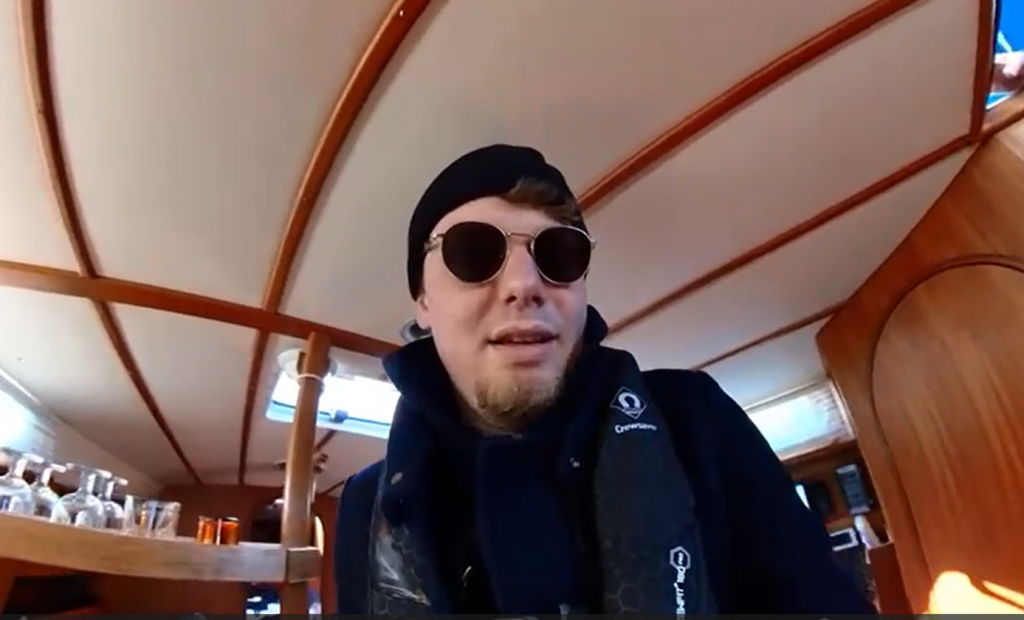
The hydrogenerator first purred away super quietly for about 2 hours and fed in an average of about 5 – 6 amps. However, when the speed then repeatedly increased to more than 7 knots and the generator occasionally supplied more than 12 A, the controller repeatedly forced it to shut down. This is a bit annoying, as we still have more than 24 hours of sailing ahead of us with maximum power consumption (6 – 8 A) from the fridge, autopilot, radar, on-board computer and screens. We are working closely with the manufacturer to adjust this.
For the time being, we start with a relaxed watch rhythm of 2 hours, shorter if necessary. By late evening we have passed Borkum and set the Dutch courtesy flag.
Saturday April 15
Throughout the night it is fantastic sailing with 5 Beaufort from astern. Pauli insisted on being able to sleep continuously for 4 hours during the night and so we agreed that he should have the longer free watch from 00:00 – 04:00 and I from 12:00 – 16:00. So I have a slightly longer watch during the night. Above me is a fantastic starry sky and on the horizon there are always new beacons, which I identify and record to pass the time. Around 2 a.m., an intense sea glow begins, which accompanies us until the first dawn.
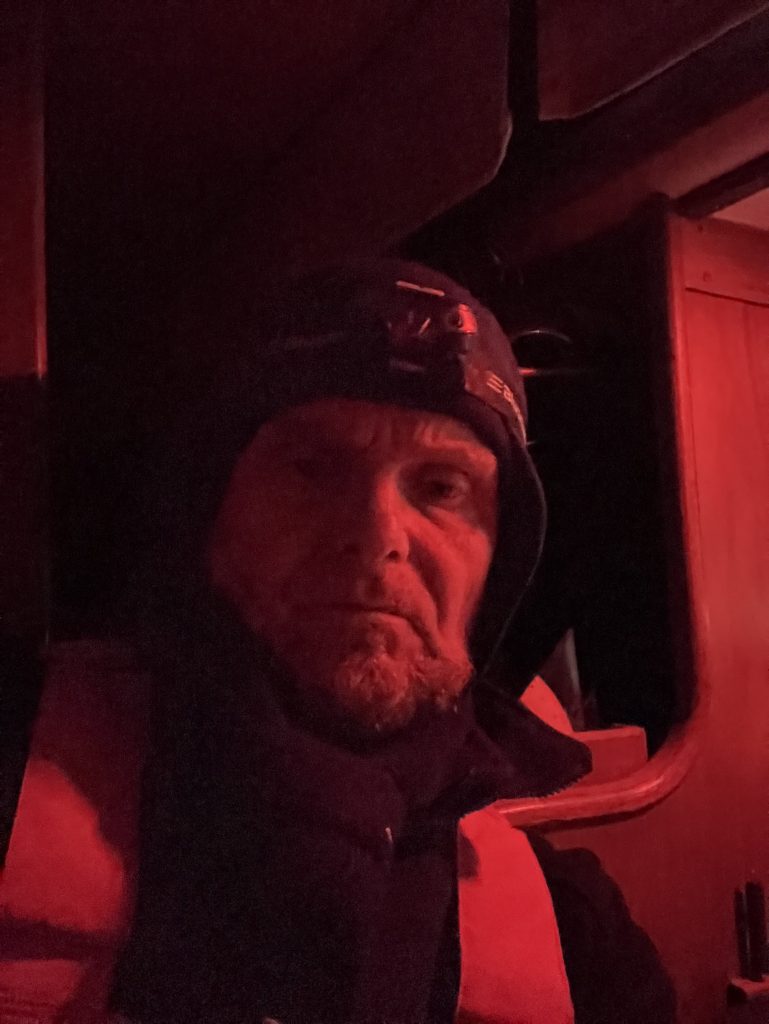
At dawn we get a catamaran in sight, which is on a parallel course and stays in sight until the evening, sometimes ahead, sometimes behind us. In the course of the day, the wind picks up a little more, so that we are sometimes sailing at 6 – 7 Beaufort or from astern. Again and again we have surfs in the 2 -digit range, at the peak even once briefly 14 knots on the log. Around noon we are at the height of Den Helder. The rough waves give Pauli a bit of a hard time and the rudder shaft starts to squeak with every movement of the rudder. We have to shift both sails several times on this section, which is quite an action with up to 7 Beaufort.
All in all, we make good progress and in the evening the silhouette of The Hague and Scheveningen is visible on the horizon. At around 11 p.m. we enter the harbour entrance of Scheveningen in rather rough seas, not without first announcing ourselves properly by radio. The harbour is divided into several basins and the passages are sometimes quite narrow. Especially when there is a lot of wind, an encounter with a large ship here could be unpleasant.
To our surprise, the marina and especially also the guest ponton is completely full and there are already boats in the row, which we then do as well. It’s not the rule on the Baltic Sea, but the big marinas in the west and south are always locked to the outside and you can only enter them if you know the numerical code for the doors. The same goes for showers and toilets. Fortunately, we can then book the berth via APP and thus also get the numerical code.
Etappe 2: Scheveningen – Dunkerque, ca. 100 nm, ca. 18 h

Sunday April 16
The start time was set for 10:00 a.m. on the assumption that at an average speed of 6 knots we would have passed Dunkerque at 3:00 a.m. and be on our way to Calais to be able to pass the narrowest part of the English Channel from about 5:00 a.m. with the tidal current running with us, with the destination Boulogne.
Unfortunately, the wind drops more and more in the course of the day, so that we still have an unpleasant swell for a long time, but already in the early afternoon we have to run the engine to make some progress. Towards evening we are at the height of the Westerschelde and I remember my first trip on the North Sea right here in the early 70s (of the last century ;-)) from Veere to Zeebrugge. The wind has fallen asleep and with an average speed of about 5 kn we are getting so slow that we will not be able to keep to our schedule for the passage through the English Channel.
The waters off the Belgian coast are characterised by some shoals that you have to navigate out carefully, as you have little space due to the nearby traffic separation area. There is also some traffic. The periodic tapping at a large steelworks south of Dunkerque keeps sending its bright flame up into the night sky like a mysterious, alien beacon. At around 4 a.m. we decide to call at Dunkerque to get a few hours’ sleep. We easily find a place at the guest jetty of the local marina.
Etappe 3: Dunkerque – Boulogne, 35 nm, ca. 5 h

Monday April 17
A few hours of sleep have worked wonders and we can set off again on our journey well rested. The wind is forecast to be favourable at NE 3-4. After we have paid the mooring fee and quickly stocked up on diesel, we head out into the North Sea again around noon. Wonderful sailing with the jib out. We encounter very few yachts and many ferries on this 35 nm trip. Towards evening we enter Boulogne in beautiful sunshine. The harbour is tide-independent and has clearly seen better times. In addition to some mostly empty industrial harbour basins, there is a former large fishing harbour on the main channel, which is currently being completely demolished and rebuilt. We see a total of 3 – 4 fishing boats, otherwise the harbour is largely empty. At the far end, just before the lock gate, there is a small marina with guest berths, where we pay an astonishing 50 € for the night. It is sufficiently deep here despite low tide. The tidal range of more than 8 m is impressive.
In the meantime, Paul has decided to return and has already booked the necessary tickets via Trainline. His return journey by train via Paris and Karlsruhe will take over 20 hours. I am glad that he was able to experience a pleasant part of the trip at the end and will hopefully keep it in good memory.
After several days and nights with very little sleep, there is now the prospect of sleeping through the night again. I study the weather forecast and the possible route for tomorrow. The wind is forecast to be northerly with peaks of 28-30 knots around midday. Should I really take the plunge alone to Cherbourg with a distance of almost 140 miles? Or would it be better to sail only 100 miles to Le Havre and then see what happens? I decide to postpone the decision until the following morning and get up early at 6am so that both options can work.
We end the evening with a beer and good conversation.
Etappe 4: Boulogne – Le Havre, ca. 100 nm, ca. 15 h

Tuesday April 18
Even before breakfast, a glance at the weather forecast shows that the strong winds on the Baie de la Seine will continue and I decide to only make the trip to Le Havre today. For the first stretch alone in this new and challenging area, that’s enough for me for now and I feel good about the decision.
After a good breakfast, Paul packs his things and it turns out that there are still 2 boxes left with various protein bars, bagged food, sweets and drinks that he had brought with him. While all this remains on the ship by necessity, he disembarked at half past eight with 2 rucksacks packed full and set off for the station.
It is a pity that he is already disembarking, but I understand and respect his intentions. And I am very glad that he accompanied me for the first few days. It’s so much easier when you can discuss serious decisions with a knowledgeable companion or just not be alone when things get tough. On the other hand, for me, almost nothing beats the experience of being all alone on the sea, fighting in harmony with the elements to move forward and arrive safely. This strong feeling – to be absolutely at the mercy of the elements and at the same time completely at their mercy – always feels like a revelation.
I leave, set the double reefed main in the outer harbour and pass the harbour exit shortly after 9 am in bright sunshine and a moderate north wind. Outside, the wind picks up quickly and we head south with the sails down and the tide running with us at first. A 2 – 3 m high wave quickly builds up and when surfing down, the log occasionally exceeds 12 knots. Find here a short video:
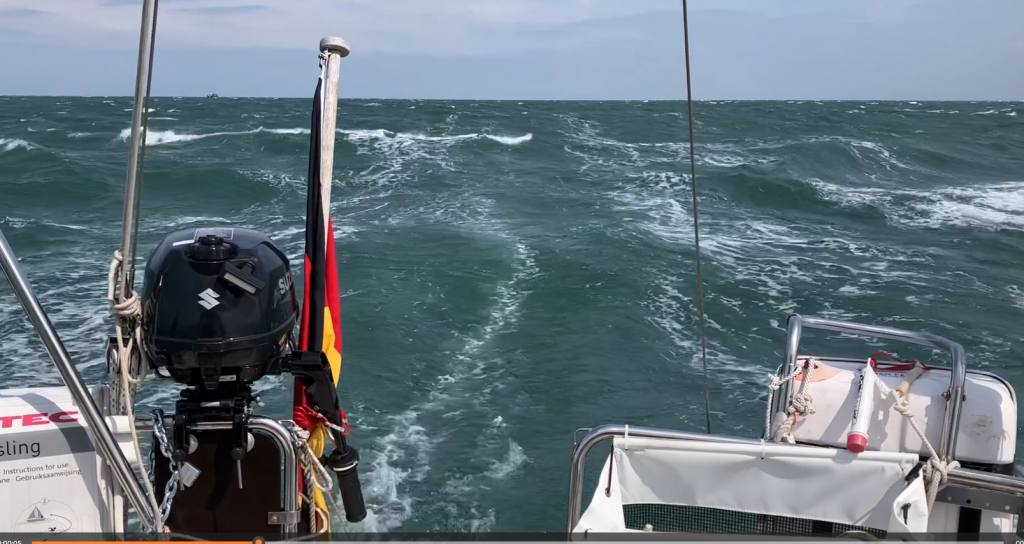
Unfortunately, the rudder is squeaking like hell again and I’m increasingly worried that the lower rudder bearing might have come loose in the coker and could be spinning along on the wave, with considerable consequences for the coker and ultimately the safety of the ship. As the wind is sometimes westerly, sometimes easterly from the north, I have to repeatedly hoist the sails, which is quite an effort in this wind. Each time I turn the jib all the way in and then have to go to the foredeck to unhook the spinnaker pole and the makeshift sheet on the leeward side and re-hook them on the new windward side. After that, I have to hoist the main boom, re-set the bull stand and unfurl the jib again. Once I forget to close the carabiner for the makeshift sheet correctly and the next time I hoist I find it bent up. Fortunately, that turned out all right.
It is sunny, but also rather hazy, so that I can unfortunately only see the magnificent and high cliffs of the Opal Coast shimmering dimly through the haze. The lack of sleep of the past days and nights is starting to make itself felt more and more. Due to the tidal current now running against us, the speed over the ground has dropped to 4-5 knots at times and at the same time the wind is increasing and the wave pattern is becoming rougher. This is frustrating and exhausting given the remaining distance. In the early evening I actually consider walking to Fecamp and continuing directly from there to Cherbourg the next day. That wouldn’t necessarily have been a bad plan, but then I didn’t dare to enter this first tide-dependent and northwest-exposed port of this trip spontaneously and without careful planning. So we continue into the night towards Cap d’Antifer and on to Le Havre at the mouth of the Seine.
Around midnight, the wind has decreased considerably in the meantime and I have long since reefed out, we sail an ESE course into the mouth of the Seine towards Le Havre in Port Plaisance. The last few miles are wonderful with 3 – 4 Beaufort and smooth water, and then we sail under engine into the marina at night. Calling at an unknown port at night is always a special experience. I find a comfortable place at the guest bridge and fall exhausted into the bunk.
Wednesday April 19
The next morning I get a good night’s sleep and when I arrive on deck at 9 am in bright sunshine, I am very positively impressed by the bright and elegant impression the marina and the city make. The marina is huge, with over 1,000 berths spread over 2 basins. The house facades are predominantly white and well-kept, framed by an elegant, Mediterranean-looking promenade and lively shipping traffic on the sea side. For the first time, I feel like I’m on holiday on this trip.
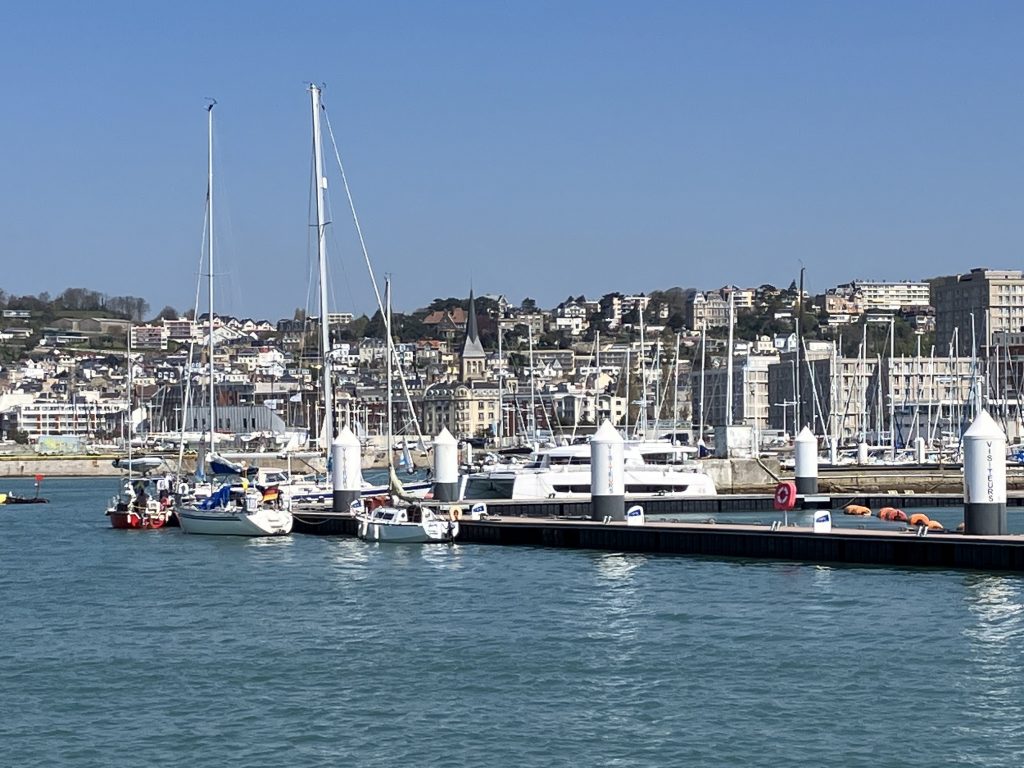
After checking the weather forecast, I decide to stay here and spend a relaxing day in the harbour in this surprisingly beautiful French town. I skype with Sophie, stroll through the streets and to the beach, buy a replacement for the bent carabiner, cook and clean a bit and decide to leave the following day at around 7am to catch the tidal current before Cherbourg.
Etappe 5: Le Havre – Cherbourg, ca. 70 nm, ca. 10 h

Donnerstag, den 20.04.2023
After getting up, I check the weather forecast and find that there will be a few peaks of over 25 knots of wind today, but otherwise the predicted NNE between 4 – 5 Beaufort should not be a problem. Between Barfleur and Cherbourg strong tidal currents are to be expected and the trip is therefore calculated in such a way that I have the capsize of the tidal current approx. 10 nm before Barfleur and then a running current until Cherbourg. Find here a Video über TIMEZERO Navigator zur Unterstützung der Gezeiten Navigation:
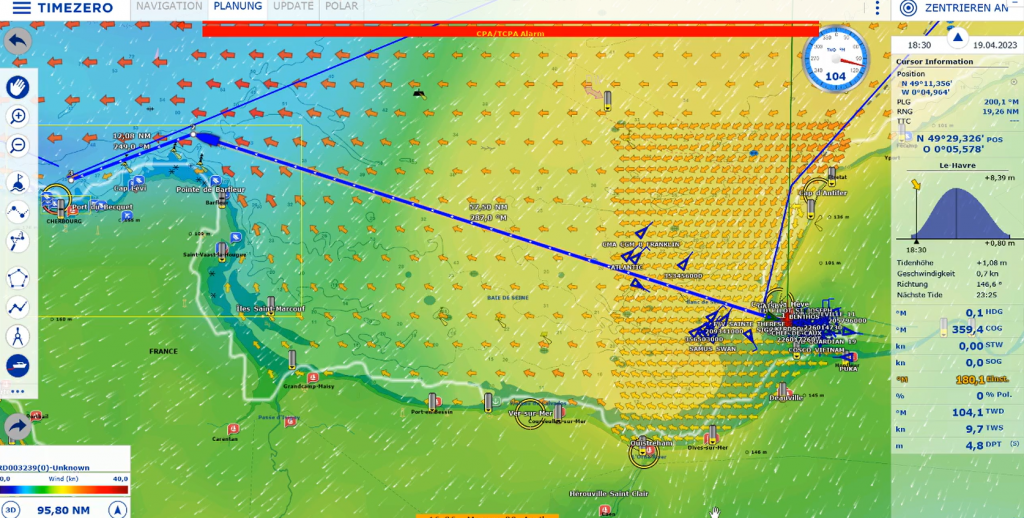
I again enjoy wonderful sailing in bright sunshine. However, there is considerable commercial ship traffic here; Le Havre is the second largest seaport in France after Marseille. At first I’m surprised at the frequent helicopter flights, and helicopter pilots can also be heard on the VHF. Until I realise that the pilots are transferred to the ships and back by helicopter. The helicopter stays in position above the steamer and the pilot is then winched down or up. Adventurous. The coordination of an evasive manoeuvre with a container freighter, which in the meantime comes on a collision course for me, works without any problems by radio.
The wind comes in at about 120 degrees from the left and increases in the course of the morning, as does the wave. The autopilot has its work cut out for it and the squeaking rudder grinds my nerves. The worry about the rudder bearing possibly slipping becomes a mental burden and I have to force myself to calm down again and again.
The waves coming from the dwars are getting higher and the autopilot is working more and more violently. I observe that the heading of the electronic compass fluctuates a lot around the COG and this fluctuating deviation also seems to contribute to the excessively violent movement of the autopilot. The heading starts to drift further and further to port, until it finally deviates permanently by 60 or more degrees from COG. There’s no way this is right, something is going wrong. Really scary.
I turn off the autopilot and steer by hand for the next few hours. In the process, I realise how much work the autopilot normally does on the road, and does it continuously. And you take it for granted. I’m very impressed and realise that I don’t really have a backup for when the autopilot fails. And in these conditions, with winds between 5 and 6 Beaufort and corresponding waves, I wouldn’t even be able to safely turn the boat both ways for any length of time without going to the helm. For the first time I ask myself whether it is really a good idea to want to sail the ship single-handed across the Bay of Biscay.
In the early afternoon, the current capsizes and begins to run with it. At the height of Barfleur, the wave pattern starts to become chaotic, with large eddies and sometimes very steep waves forming. At some point a wave actually comes in over the stern, fortunately not very strong and the water quickly runs off again, but still: for me the first time.
Later on, the wind drops more and more and in the late afternoon, the outer pier of Cherbourg comes into view. Only when I enter do I realise what a gigantic structure it is. The sheltered harbour created by it is certainly 4 nm wide and 2 nm deep, unbelievable. While I’m packing up the sails and the boat is chugging towards the harbour, I suddenly hear a puffing noise and a splashing from the side and at first I can’t believe my eyes: are those really dolphins cavorting around? And yes, I am greeted by two dolphins that appear to the right and left of and in front of the boat, finally drop back and say goodbye with a fantastic double jump, which I can even film briefly. Find here a short Video:

I enter the huge marina and quickly find a good spot at the guest jetty. At this time of year, it’s not as busy as it is in summer. The marina has 1,600 berths and all the facilities a skipper’s heart could wish for: chandlery, boatyard, sailmaker etc. You can well imagine why this marina was chosen as the destination for the Admirals Cup. Like all harbours since Scheveningen, this one is well filled, there are hardly any boats left ashore. The season starts much earlier here than here on the Baltic Sea.
The forecast for tomorrow is NE, but it’s supposed to go to sleep in the evening and then turn W. That’s too shaky for me. That’s too shaky for the 170-mile trip to Camaret sur mer, which is actually next. For one thing, I want to somehow try to get to the bottom of the thing with the squeaking rudder. On top of that, there is an increasingly dripping heat exchanger on the engine, which worries me and makes me minimise the engine running times. Reason enough for a port day and if I should break something while screwing, there are all kinds of possibilities to get professional help here.
Friday April 21
Harbour day, first a leisurely breakfast. Then I take a look at the heat exchanger: the inlet from the seawater pump is leaking, it drips here when the machine is running, all the other inlets seem to be tight. I suspect that the seal is porous and needs to be replaced, but I don’t dare pull out the connection piece because I’m afraid of destroying the seal completely. I don’t have a replacement and I’m sure I won’t be able to get one for such an old engine here any time soon. I decide to put up with the dripping for the time being and observe it.
Next I turn my attention to the rudder and notice that the two quadrants for rudder and autopilot as well as the rudder position sensor do not match exactly, but deviate from each other by a few degrees. Maybe this is the reason for the increasing irritations of the autopilot? I bring all 3 into exact alignment. As I suspect that the squeaking could also be caused by a completely dry upper rudder bearing, I try to moisten the shaft above the bearing in the hope of causing water lubrication.
That’s all I can do today with on-board equipment. I get into a conversation with the skipper of a Polish yacht that is on its way to Greece and has sailed non-stop from Cuxhaven to Cherbourg. They want to sail on to Camaret tomorrow and then across the Bay of Biscay, which is exactly what I had planned. The skipper offers me the chance to sail in a convoy, but I decline: there are three of them and – unlike me – they can afford to sail for days and nights on end, even under engine power if necessary. That would be too much for me.
Later I stroll through the town and in the early evening I stop at a nice restaurant at the harbour. The forecast for tomorrow is for calm in the morning and NW 3 – 4 in the afternoon, later turning SW, not good conditions for a 170-mile trip to the SW, especially as the tidal current only capsizes around 11:00 and begins to run west. It makes no sense to leave before 11:00. I consider splitting the leg and just going to Guernsey tomorrow. I increasingly like the idea and buy a courtesy flag for Guernsey.
Etappe 6: Cherbourg – Guernsey, ca. 44 nm, ca. 6 h

Saturday 22 April
The day begins calmly and I take it easy. I buy a nice crispy baguette in town and set sail around 11:00 am. In the large outer harbour I reset the autopilot and reinitialise it. After that, all the parameters are right again for the time being. But I will only really trust the autopilot again once it has steered cleanly for a few hours in rough seas and wind without any deviations.
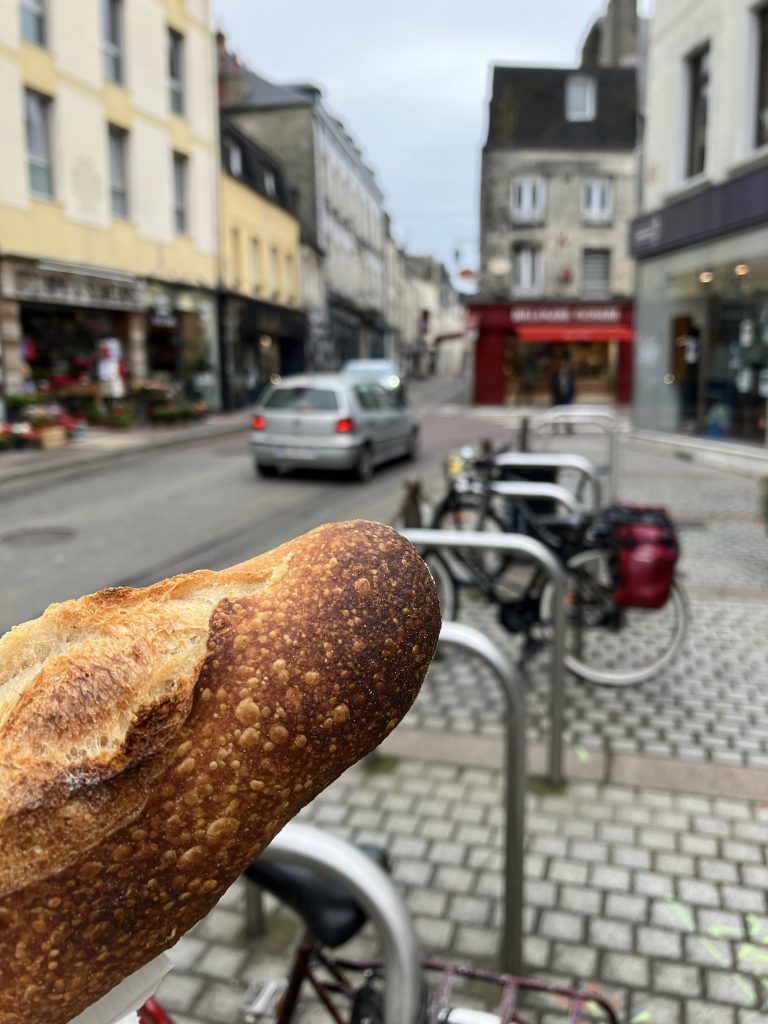
For the first two hours, I run under engine power with the tidal current increasingly moving with me. I’m terrified of the Alderney Race and don’t want to get caught in it – especially now with the new moon. The passage to the west of Alderney seems reasonable to me, however, as according to the chart much lower current speeds are to be expected here.
In the late afternoon, a NW wind with around 3 Beaufort comes up at Cap de la Hague, which allows me to approach the passage west of Alderney and then drop off towards Guernsey. Wonderful sailing under full sail and a running current with up to 10 knots over ground. As I enter the sound between Herm and Guernsey in the late afternoon with the onset of calm water, a huge squall builds up in the west and hits me with full force just before I enter Saint Peter Port. Visibility is abruptly gone, but fortunately I have the outside screen on which I can see exactly where I am and where I have to go.
Still in the entrance I suddenly have a RIB next to me and a friendly Harbourmaster asks if I want to go into the inner harbour. The passage of the Sill is just possible and there are free seats inside. For the time being, I prefer the guest pontoon in the outer harbour to get my bearings and decide if and when I want to continue. I get the documents for clearing in and, in the pouring rain, help with mooring at the pontoon.
While filling out the documents, I am surprised to realise that a passport is required for entry and that the flag Q must be set until official clearance has taken place. I have neither. I quickly conjure up a flag Q from a yellow bed sheet, which I dutifully place, and have Heike send me a photo of my passport via Whatsapp. The latter costs me over 50 € because of the brutal roaming conditions of my provider.
Sunday April 23 and Monday April 24
The weather forecast predicts westerly winds of up to 25 knots and squalls for today and tomorrow. Under these circumstances, sailing upwind towards Brest is out of the question for me. Paimpol or Lezardrieux , where I could sail with half the wind, are no use either, also because I don’t want to get to know any unknown, tide-dependent entrances with a strong onshore wind. The day after tomorrow the wind is supposed to shift back to NNE, so I could sail through to Camaret in one go. I decide to stay and enjoy 2 harbour days in Saint Peter Port.
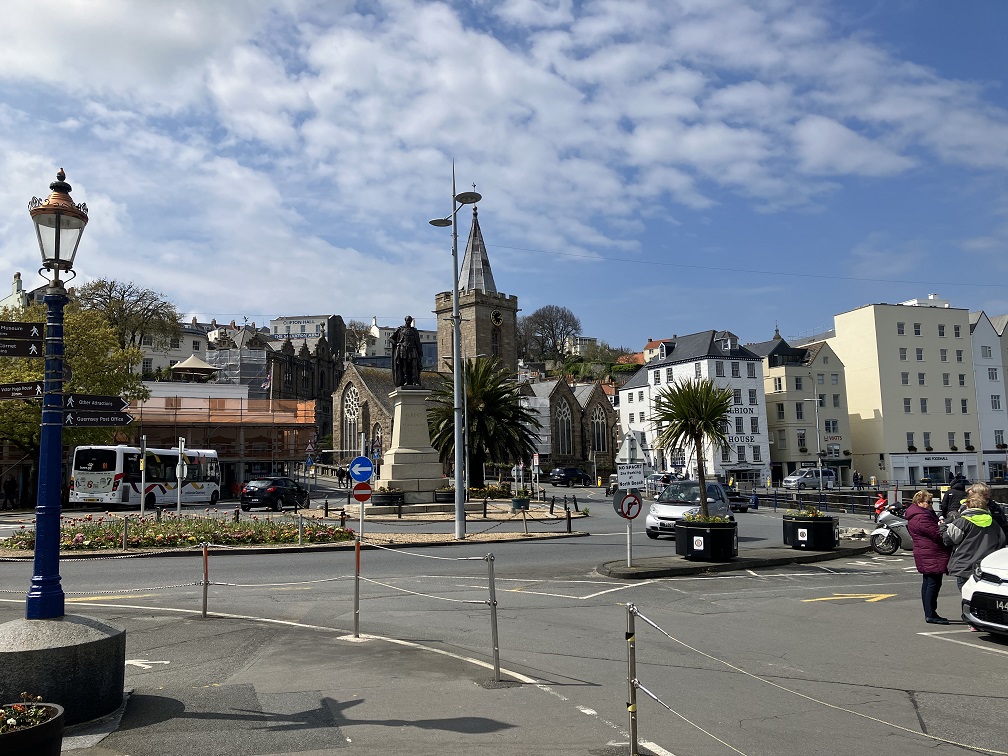
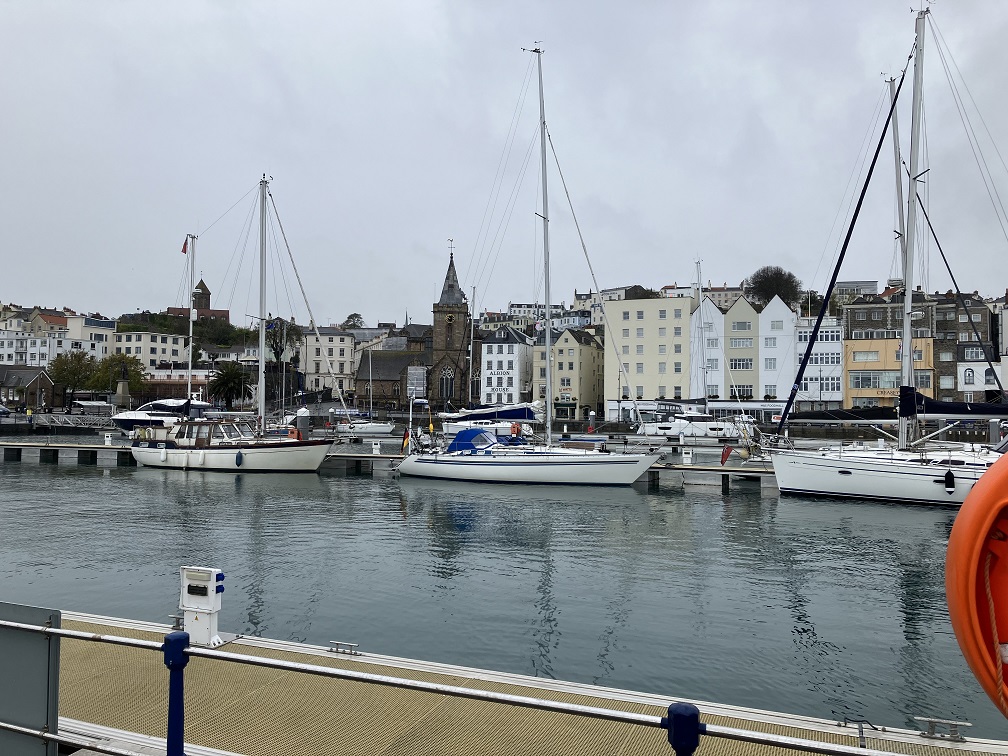
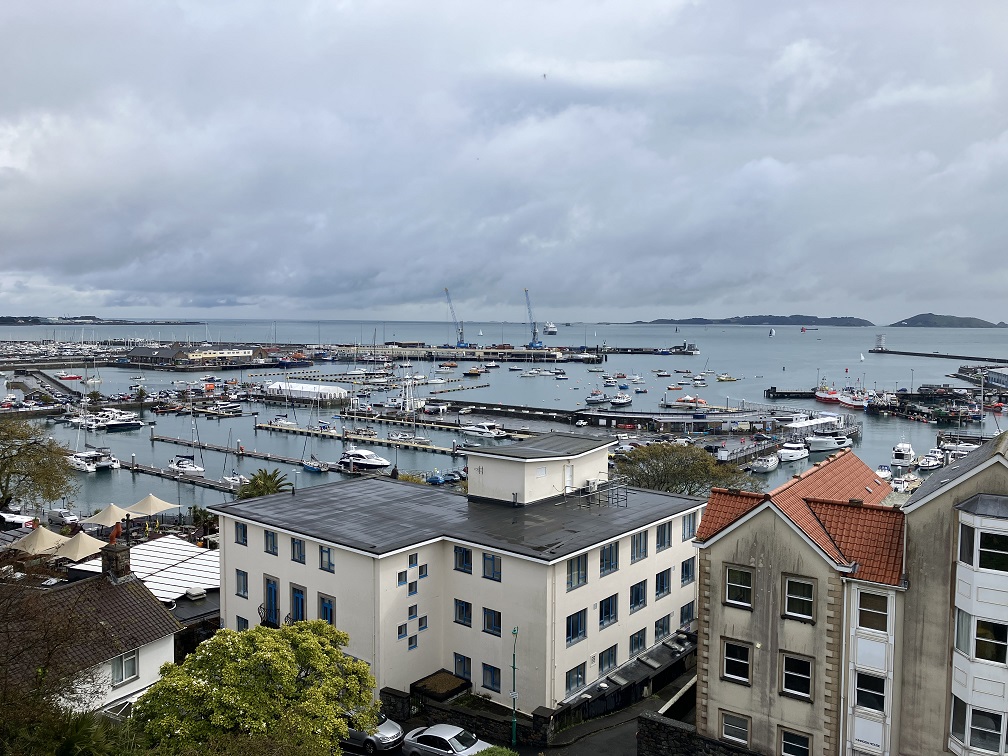
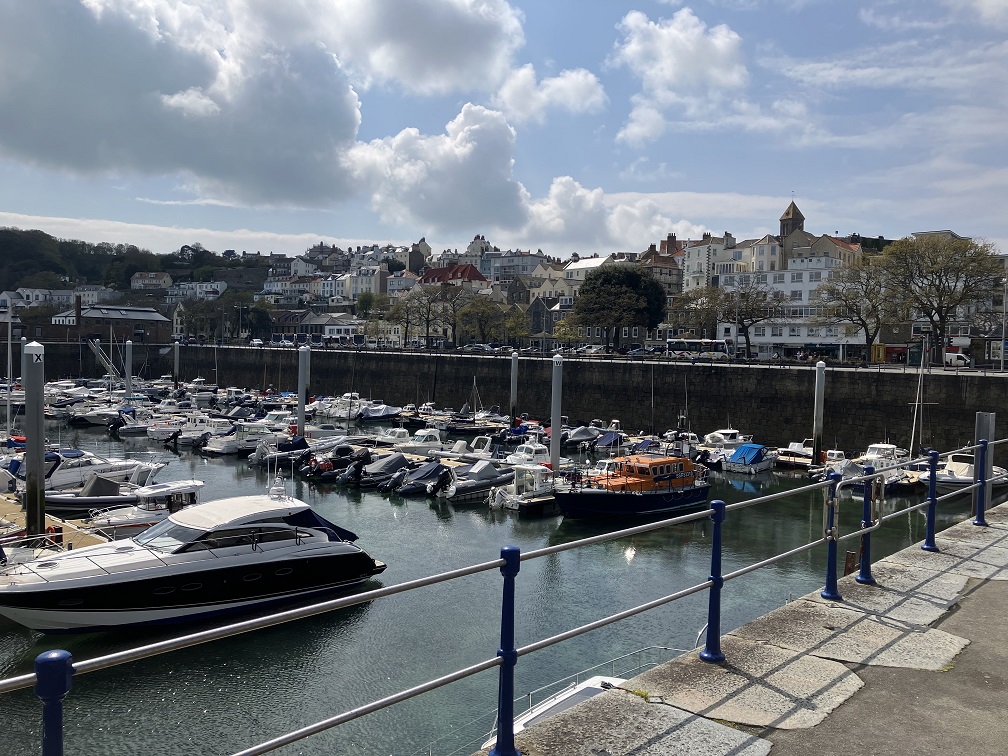
Slowly I have to come to a decision whether to use the remaining days of my holiday to go from Camaret sur mer across the Bay of Biscay as planned, or whether to stay on the French Bay of Biscay coast in southern Brittany for the time being and solve the biggest technical problems (squeaking rudder and dripping heat exchanger). From the end of the week, rather weak winds are forecast for the Bay of Biscay, which would mean long hours of motoring. This, and my still unrestored confidence in the autopilot, are the deciding factors: I’m leaning towards not going across the Bay of Biscay just yet.
For southern Brittany, however, I still don’t have a chart backup (neither digital nor paper). I’m having no luck with the local yacht chandlery, where I only find piecemeal charts, and they’re out of date. I order the digital charts from NV Verlag and download them to my iPad.
Tomorrow, Tuesday, I want to leave early in the morning, but the Sill will not be passable until around 09:00. I’ll therefore leave in the evening at around 21:00 and moor the boat to the pontoon in the outer harbour, so that I can start tomorrow morning, regardless of the tide. I could make the passage to Chenal du Four in about 15 hours. However, the tidal current will capsize around 6 pm and run north for the next 6 hours, so the passage of the Chenal du Four in the evening no longer makes sense. Instead, L’Aber Wrack is a good place to spend the night.
Etappe 7: Guernsey – L’Aber Wrack, ca. 100 nm, ca. 15 h

Tuesday April 25
I start early at 06:00, before the ferry to England. The wind comes as predicted and pushes the boat along briskly with the sails out. As I sail along the beautiful east coast of Guernsey, a cruise ship comes towards me, slowly passing the Sound.
The crossing goes smoothly, the autopilot steers without problems under these rather favourable conditions (NW, later NNE 4 – 5 Beaufort, sea 1.5 m). Only the squeaking rudder torments my nerves.
For lunch – as is often the case at sea – I have a bag of Tactical Foodpack. It’s so convenient and safe to prepare, even under rough conditions, and it actually tastes reasonably good, that I’ve given up preparing fresh food on long trips. For the sake of convenience, coffee also comes out of the Nespresso machine, which works smoothly and safely, even in the situation and the waves. In the early afternoon, a school of dolphins accompanies me and I manage to take a short video:
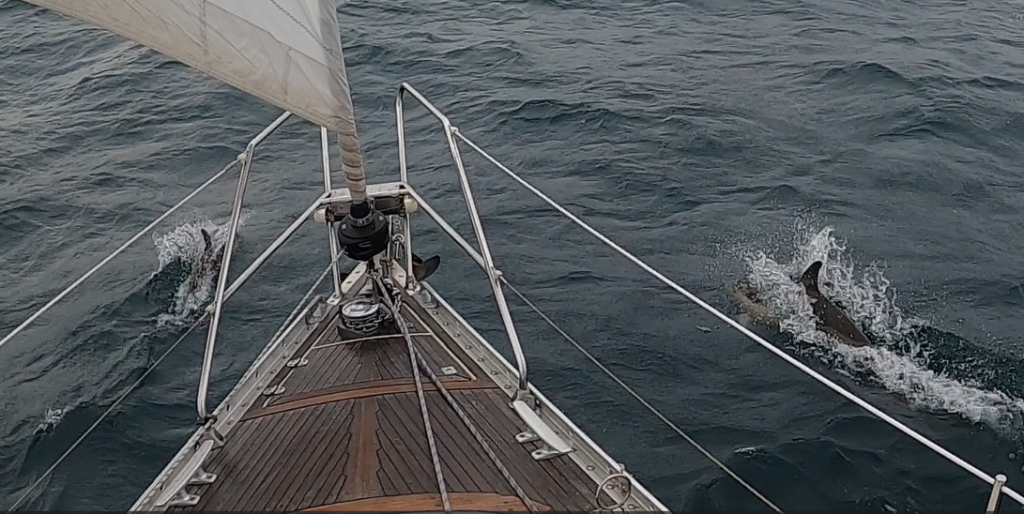
Towards evening the wind dies and I reach the entrance to L’Aber Wrack in moderate conditions. It is just before HW and the current is pushing NE at 2 knots and there are some clearly visible sea marks. Nevertheless, it remains a tricky and exciting entrance between the rocks. I motor up the beautiful river and moor at dusk on a mooring in front of the harbour. What a pleasure to have arrived here and to experience the peace and quiet in the evening without any time pressure.
Etappe 8: L’Aber-Wrack – Ile de Sein, ca. 40 nm, ca. 8 h

Mittwoch, den 26.04.2023
The day begins with rain and I take it easy. I don’t need to start before 11:00 a.m., because the current in the Chenal du Four doesn’t start running southwards until around 12:00 p.m.. In the morning the rain stops and is replaced by patches of fog, which a light wind from WSW drives inland. A small fleet of Opti and Teeny sailboats is racing in front of the harbour. You really do see ambitious young sailors everywhere here in France. Sailing as a popular sport has a completely different status here than in Germany.
Despite the poor visibility, I start around 11:00 a.m. and motor with the main set for the first two hours against the light wind. It’s good to have radar here to compensate for the poor visibility. At noon it clears up and I can head S with main and jib. Now I meet a few yachts, including a Class 40 in training mode and a German ketch heading north.
The wind has evened out, the sun is shining and we are sailing at 5 – 6 knots, wonderful. Late in the afternoon I reach the southern exit of the Chenal du Four and can’t decide to go the 12 miles from here towards Camaret sur Mer. Firstly, because I would be deviating from the shortest route to the south, and secondly, because the forecast is for a SW wind of around 4 Beaufort tomorrow and I would then have to cross the first 15 miles from Camaret.
The wind decreases a bit now, but I continue to sail south towards the Ile de Sein. In front of me, 2 more yachts are sailing directly towards the Raz de Sein. A wonderful evening atmosphere, it could go on like this forever. I briefly consider whether I should take advantage of the time window and the calm conditions and pass the Raz de Sein this evening. I decide against it, however, because the next harbour would be Audierne, from where I would again have an unfavourable starting position for the forecast SW wind tomorrow.

According to my calculations, the next time window for the passage of the Raz de Sein (still water – before the current turns S) is tomorrow between 09:30 and 10:30. My plan is to anchor for the night off Ile de Sein and pass the Raz tomorrow with a forecast SW wind. Suddenly I’m called directly by the coastguard on the radio and asked what I’m up to. I briefly explain my plan and get their best wishes for the journey ahead. I am amazed that there is actually such close surveillance here. In view of the risks that a careless passage of the Raz de Sein can entail, this is certainly very sensible and helpful.
I moor at a mooring between the rocks in front of the harbour of the Ile de Sein. Apart from me, there is only one boat of the “Sauveteurs en mer” moored here and it is lonely and quiet. Only the water is constantly in motion, you can feel the great energies that are released here in the constant change of the tides. Every now and then a dark murmur, like the slurping of a deep gorge, sounds up between the rocks. I enjoy the evening and feel comfortable and secure with my plans for tomorrow.
Etappe 9: Ile de Sein – Huedic, ca. 100 nm, ca. 15 h

Thursday 27 April
At 4 a.m. I wake up to the rain and the rattling of the halyards. It has freshened up and I realise with horror that a SE wind of 5 Beaufort is driving an unpleasant swell between the rocks. SE wind means that I would have to go right upwind through the Raz, which is of course out of the question. Motoring against the wind at 5 Beaufort and with a time window of 1 hour in one of the wildest tidal waters: impossible.
I lie down again for the time being. When it gets light, the rain stops, but it is foggy and cloudy and the wind continues to whistle from the SE. The island and the rocks are only dimly visible. Under these circumstances, all I can do is wait. If I can’t use the time window from 09:00 for the morning passage, I have no choice but to stay here at the mooring for another 12 h until the next time window and wait. With the prospect of motoring through the night afterwards, because the forecast is for calm from the evening onwards. I briefly consider going west around the Ile de Sein and the offshore reef, but when I realise that this means a diversion of 30 nm, I discard the idea.
Around 09:00 the wind starts to drop a little to 4 Beaufort and veer S. With a southerly wind I could moor and sail around the Ile de Sein. With a southerly wind, I could tack and set the main in support of the engine. Visibility is still very poor and the boat is in a choppy swell. I waver whether I should dare to start. I carefully check the time window for the passage again, also on the basis of the instructions in the reeds. Everything fits in terms of time. I take heart and get the ship ready for take-off. Under engine power, we first head north out of the tangle of rocks, then southeast with the support of the reefed mainsail through the turbulent tangle of waves in still water.
Numerous eddies and undercurrents make for a completely confused and unpleasant wave pattern. In the fog, a fishing boat appears on the port side, sailing a parallel course. I make better progress than I thought and the wind slowly shifts beyond south to southwest. It’s running now and slowly I can relax. After an hour I add the jib and can switch off the engine. Slowly the fog lifts and visibility improves.
In the course of the day, the wind shifts further and further out of the west to north-west and also picks up again to 5 Beaufort. From time to time I am able to jib out and make good progress. By early afternoon I’m already at the Iles de Glenan, my original destination. As things are going so well at the moment and a calm is forecast for tomorrow, I set course for Bel Ile. To my great delight, I get another visit from a school of dolphins in the early evening. I set sail and reach the northern tip of Bel Ile late in the evening.

There is almost no swell and the moderate wind pushes the ship along well. Visibility is good and the beacons are easy to see. I decide to take advantage of the good wind and sail past the island. Around midnight, I carefully thread my way through the shallows between Houat and Ile d’Hoedic under engine power and moor in Port de l’Argol. When I moor, I notice that my diesel exhaust smells different and stronger than usual, but I don’t attach any importance to it for the time being. I am amazed that all the moorings here are occupied and that there is still life on the boats at 1 a.m.: a dinghy brings people from the harbour onto their boat, someone stands in the cockpit and smokes, quiet snatches of conversation drift across the water. Almost like a summer evening on the Baltic Sea.
Passage 10: Ile d’Hoedic – Pornichet, 22 nm, ca. 4 h

Friday 28 April
The next morning begins windless, warm and with a thick fog. Early at 9 a.m. I get a visit from the very nice harbour master in the RIB. We chat a little in English and I understand that I can call her on channel 9 if I want to go ashore. My own dinghy is still packed and not ready for use.
My holiday is slowly coming to an end and I now have to think about where to leave the boat for the next few weeks. I look at the harbours within a radius of 20 – 30 miles under the criteria of tidal dependence, yacht outfitters and slip, repair and shopping facilities as well as rail and air connections. Finally, Pornic and Pornichet on the left and right of the Loire estuary crystallise out as options; both have good access from the sea and good rail connections to Nantes. I first call Pornic and am asked to request a berth by e-mail, which I dutifully do. However, they cannot promise me anything. I also book a flight ticket from Nantes to Berlin for next Monday, 1 May.
A sailor from the only other German yacht in the harbour comes over with his dinghy and we chat for a while. He has the ship permanently moored in this region and can tell me a thing or two and give me a tip or two.
The conspicuous exhaust fumes continue to worry me and I read everything about white, black and blue smoke in the exhaust fumes of a diesel engine. In my case, if it is blue smoke, it would probably be a disaster, because sooner or later the engine is usually ruined. However, the engine always runs quietly and smoothly and starts immediately and perfectly under all conditions, so I can’t really believe that I have a serious problem. We will see.
In the early afternoon the fog lifts and there is a very light breeze. I cast off and after an hour of motoring, the northerly wind is sufficient to sail. It is a gentle and quiet end to my farthest and most beautiful single-handed trip so far. When I arrive in Pornichet in the evening, I can’t believe my eyes: the harbour is full of Pogos and other racing yachts, and at first glance there really isn’t even the smallest berth free. There must be an international regatta event taking place here this weekend. I screw my way deeper into the harbour and finally find a place for the night in the 2nd row alongside a 50-foot yacht.
Over the next few days, I manage to arrange with the very nice people in Capitanerie that I can leave the boat here for the next few weeks. I even get a proper place at the finger jetty where the ship can lie safely and well. When packing the mainsail, I discover that one masthead is completely broken and two more are about to break.
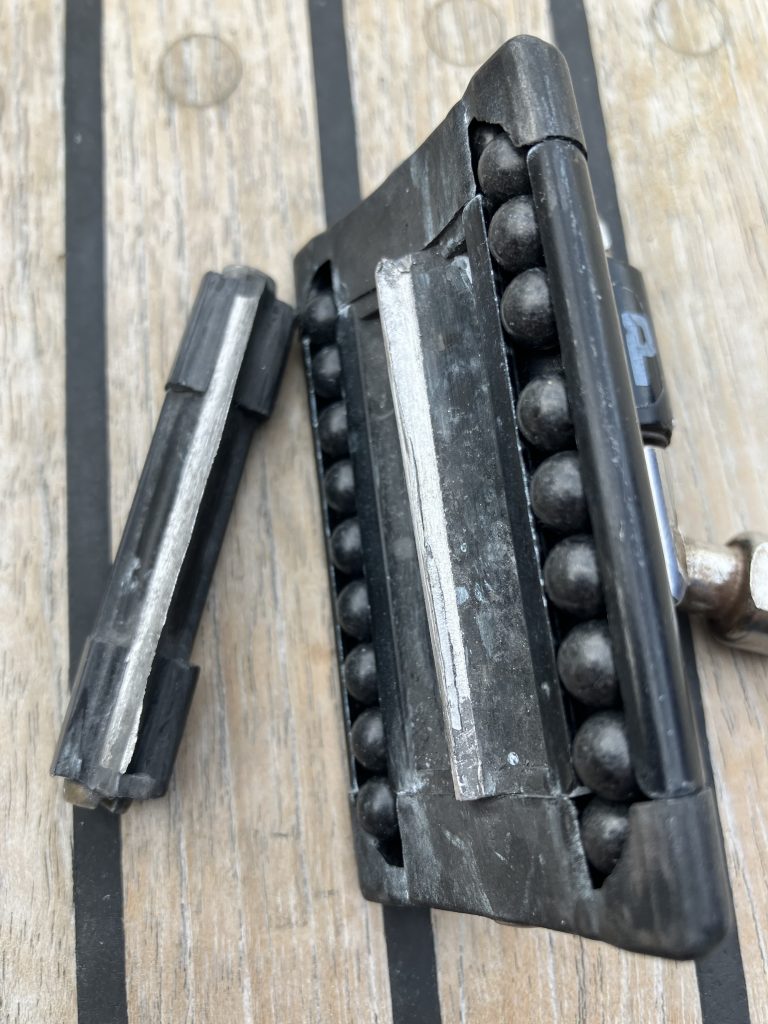
So now I have another problem to solve.
And it was right, with all the problems breathing down my neck, not to go over the Bay of Biscay for the time being, but to clarify things calmly and look for solutions. I don’t want to tackle a challenge like the Bay of Biscay if the ship is not absolutely flawless and intact.
Addendum and conclusion::
I was able to go back to the boat in mid-May to carry out the most important repairs. I dismantled the quadrants and the position transducer and lowered the rudder about 10 cm and then noticed during a dive that the lower bearing is correctly in place and also does not rotate with it. Great relief!!! The squeaking was actually coming from the upper rudder bearing, which had simply run dry. With the application of plenty of Teflon spray to the shaft and bearing, the squeaking disappeared.
I replaced the old and porous seal on the seawater inlet for the heat exchanger with a new one and that seems to have been it. So far there is no more dripping from the heat exchanger.
The delivery of the Ronstan mast sliders has unfortunately been delayed until early June, so I was not yet able to replace the old sliders when I visited in May.
Regarding the exhaust gases, I noticed that the stronger smoke development only occurs at idle, at 1,500 revolutions the exhaust gases look quite normal. Since the engine continues to start without problems and shows no other abnormalities, I assume that the diesel I filled up in Boulogne shows a different exhaust pattern than the GTL/BTL diesel I’ve always had in the tank so far. I’m cautiously optimistic for now, but I’ll have to keep watching.
All in all, I can already say that this has been the most beautiful and exciting trip of my life so far. I don’t regret a single second! But of course I also realised that the plan to sail from Cuxhaven across the Bay of Biscay to Galicia in 2 weeks was more than audacious. Despite the training of longer single-handed trips in the years before and despite the very extensive equipment of the ship.
I have been challenged beyond my limits several times, physically, but above all mentally. And that is precisely the elixir that these voyages bring me: getting through and successfully overcoming an overtaxing situation at sea and achieving the feasible goals with the given means.
The key point that prevented me from going ahead with the Bay of Biscay crossing in the end was the realisation of the lack of redundancy for the autopilot and the lack of possibility to leave the ship to its own devices for a few hours even in rough conditions. This possibility is absolutely essential for me as a single-handed sailor on a non-stop voyage across the open ocean lasting several days. Of course, I could have known beforehand that the autopilot could fail. But I didn’t notice this risk, or rather I suppressed it: it had always done its job reliably on all my journeys for years. Classic “availability bias” …
In retrospect, the result of this trip feels like a certain measuring: which challenges can still be mastered – measured by the quality of my preparations and my personal resources – and where should I stop. For me, it feels coherent the way I did it and I am grateful that I was able to do it.
Besides, for me as a Baltic sailor, Brittany is a wonderful and fascinating area. It’s not just the dreamlike, sometimes breathtakingly beautiful landscape, picturesque towns and harbours and the easy-going way of life of the French that I find very attractive. But what I find even more fascinating is the unmistakable omnipresence of the sea with all its exciting aspects such as fishing, seafood, leisure activities, weather, … And especially the subject of tides, which I perceived from a distance as rather annoying and risky, turns out to be particularly connecting with the sea and the landscape after a short period of getting used to it. You groove into the rhythm of the tides and begin to think about and take the tides into account rather effortlessly in all your considerations and planning. But this means that the sea is present in a completely different and more intense way than on the Baltic Sea.
The harbours are full, whether small or large. Nevertheless, or perhaps because of this, they are actively managed, especially the large marinas, but also most of the island harbours including the moorings. Friendly staff can always be reached by radio (usually CH 9) and usually also by phone. New arrivals are usually met by RIB and directed to a berth, if that is still possible. Communication in English is always possible if your French is not good enough.
I will continue to report.
-
Recent Posts
Recent Comments
- Calypsoskipper on Expose Finngulf 39
- Christian on Expose Finngulf 39
- Calypsoskipper on Expose Finngulf 39
- Kenneth Melcher on Expose Finngulf 39
- alex on Saildrive diaphragm – replace according to instructions or just keep?
Kalender
January 2026 M T W T F S S 1 2 3 4 5 6 7 8 9 10 11 12 13 14 15 16 17 18 19 20 21 22 23 24 25 26 27 28 29 30 31 Tags
12 V Verkabelung 12 V wiring Anchor windlass Ankerwinde Biscaya Bora Segel Bretagne Brittany Camaret sur mer circuit distribution Cornwall Cowes Cuxhaven Den Helder Diaphragm English Channel Falkenberg falkenbergs Båtsällskap Falmouth Gezeitensegeln havarie Hydrogenerator Lewmar Ocean Membrane MiniPlex-3USB-N2K Nordsee Norwegen Oxley Parasailor Plymouth Ramsgate Saildrive Saildrive diaphragm Saildrive Membrane SailingGen Seenotrettung Segeln in Tidengewässern Sjöräddnings Sällskapet Skagen Skagerak Stromkreisverteilung tidal navigation tidal water routing Tidennavigation ÄrmelkanalArchiv
Kategorien
